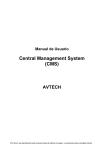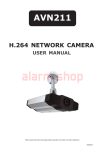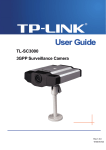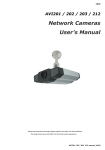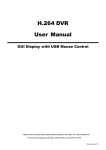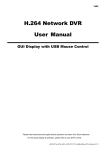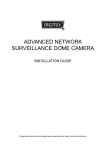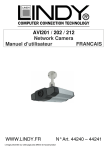Download H.264 DAY & NIGHT NETWORK CAMERA USER MANUAL
Transcript
H.264 DAY & NIGHT NETWORK CAMERA USER MANUAL Please read instructions thoroughly before operation and retain it for future reference. N204_212_system_V1.0 IMPORTANT SAFEGUARD All lead-free products offered by the company comply with the requirements of the European law on the Restriction of Hazardous Substances (RoHS) directive, which means our manufacture processes and products are strictly “lead-free” and without the hazardous substances cited in the directive. The crossed-out wheeled bin mark symbolizes that within the European Union the product must be collected separately at the product end-of-life. This applies to your product and any peripherals marked with this symbol. Do not dispose of these products as unsorted municipal waste. Contact your local dealer for procedures for recycling this equipment. Disclaimer We reserve the right to revise or remove any content in this manual at any time. We do not warrant or assume any legal liability or responsibility for the accuracy, completeness, or usefulness of this manual. The content of this manual is subject to change without notice. Grounding This is a Safety Class 1 Product (provided with a protective earthing ground incorporated in the power cord). The mains plug shall only be inserted in a socket outlet provided with a protective earth contact. Any interruption of the protective conductor inside or outside of the instrument is likely to make the instrument dangerous. Intentional interruption is prohibited. Water & Moisture Do not expose this product to dripping or splashing and that no objects filled with liquids, such as vases, shall be placed on the product. Trademark Acknowledgements Internet Explorer, Microsoft, Windows, Mozilla & QuickTime are registered trademarks of the respective holders. MPEG4 Licensing THIS PRODUCT IS LICENSED UNDER THE MPEG-4 VISUAL PATENT PORTFOLIO LICENSE FOR THE PERSONAL AND NON-COMMERCIAL USE OF A CONSUMER FOR (i) ENCODING VIDEO IN COMPLIANCE WITH THE MPEG-4 VISUAL STANDARD (“MPEG-4 VIDEO”) AND/OR (ii) DECODING MPEG-4 VIDEO THAT WAS ENCODED BY A CONSUMER ENGAGED IN A PERSONAL AND NON-COMMERCIAL ACTIVITY AND/OR WAS OBTAINED FROM A VIDEO PROVIDER LICENSED BY MPEG LA TO PROVIDE MPEG-4 VIDEO. NO LICENSE IS GRANTED OR SHALL BE IMPLIED FOR ANY OTHER USE. ADDITIONAL INFORMATION INCLUDING THAT RELATING TO PROMOTIONAL INTERNAL AND COMMERCIAL USES AND LICENSING MAY BE OBTAINED FROM MPEG LA, LLC. SEE HTTP://WWW.MPEGLA.COM. GPL Licensing This product contains codes which are developed by Third-Party-Companies and which are subject to the GNU General Public License (“GPL”) or the GNU Lesser Public License (“LGPL”). The GPL Code used in this product is released without warranty and is subject to the copyright of the corresponding author. Further source codes which are subject to the GPL-licenses are available upon request. We are pleased to provide our modifications to the Linux Kernel, as well as a few new commands, and some tools to get you into the code. The codes are provided on the FTP site, and please download them from the following site or you can refer to your distributor: ftp://ftp.dvrtw.com.tw/GPL/AV074/ Version Firmware: 1W35-1W14-1W13-1W04-A2 Video Viewer AP Software: 0130 TABLE OF CONTENTS 1. OVERVIEW......................................................................................................................................... 1 1.1 Product Features....................................................................................................................................... 1 1.2 Package Content....................................................................................................................................... 1 1.3 Hardware Overview................................................................................................................................... 1 1.4 Rear Panel ................................................................................................................................................ 2 2. BEFORE USING THE NETWORK CAMERA ..................................................................................... 3 3. ACCESSING THE CAMERA VIA VIDEO VIEWER ............................................................................. 4 3.1 Install the software .................................................................................................................................... 4 3.2 Accessing the camera ............................................................................................................................... 4 3.3 Control panel overview.............................................................................................................................. 5 3.3.1 Simplified Version (Default)..............................................................................................................................5 3.3.2 Full Function Version........................................................................................................................................6 3.3.3 Main Button Overview ......................................................................................................................................6 3.4 Frequently-used functions ......................................................................................................................... 7 3.4.1 Record..............................................................................................................................................................7 3.4.2 Playback...........................................................................................................................................................7 3.4.3 Firmware Upgrade ...........................................................................................................................................8 3.4.4 E-Map...............................................................................................................................................................8 4. SYSTEM CONFIGURATION ............................................................................................................ 13 4.1 General ................................................................................................................................................... 14 4.1.1 Log .................................................................................................................................................................14 4.1.2 Account...........................................................................................................................................................14 4.1.3 OnLineUser ....................................................................................................................................................16 4.1.4 Trigger ............................................................................................................................................................16 4.2 Network ................................................................................................................................................... 17 4.2.1 QoS ................................................................................................................................................................18 4.2.2 SNTP..............................................................................................................................................................19 4.2.3 FTP.................................................................................................................................................................19 4.2.4 MAIL ...............................................................................................................................................................19 4.2.5 Filter ...............................................................................................................................................................20 4.2.6 UPnP ..............................................................................................................................................................20 4.3 Video ....................................................................................................................................................... 21 4.4 Color........................................................................................................................................................ 21 4.5 Time ........................................................................................................................................................ 22 5. ACCESSING THE CAMERA VIA WEB BROWSER.......................................................................... 23 5.1 Accessing the camera ............................................................................................................................. 23 5.2 Control panel overview............................................................................................................................ 24 5.2.1 Live View Panel..............................................................................................................................................24 5.2.2 System Configuration Panel...........................................................................................................................24 5.3 Video recording directly to USB flash drive ............................................................................................. 26 5.3.1 Before Using Fhis Function............................................................................................................................26 5.3.2 Live View Panel..............................................................................................................................................26 5.3.3 USB Device Status.........................................................................................................................................26 5.3.4 Recorded Data Playback and Download .......................................................................................................27 APPENDIX 1 SPECIFICATIONS .......................................................................................................... 28 APPENDIX 2 COMPATIBLE USB FLASH DRIVE LIST ........................................................................ 29 1. OVERVIEW 1.1 Product Features Low-latency video streaming with H.264 compression format for sharp and clear images Supports Wireless function with an optional Wireless dongle 1/3” CCD image sensor with high quality pictures Hybrid digital / analog video output Motion detection and alarm notification functions External microphone in / audio out for two-way voice communication Day & night functionality with Smart Light Control feature for clear and accurate image 1.2 Package Content □ □ □ □ Network camera Installation Guide Bracket Adapter and power cord □ RJ45 network cable □ Alarm cable □ CD-ROM disc (including user manuals & CMS software “Video Viewer”) 1.3 Hardware Overview 1 1.4 Rear Panel CONNECTOR / BUTTON DESCRIPTION Reset Default This button is hidden in the pinhole. Press and hold the reset button until the network camera rebooted. This will reset all parameters, including the IP address to factory default settings. Power Indicator When the camera is power-supplied, this indicator will be on as red. Audio Output Support the connection to an audio device, such as a speaker, for voice transmission of the remote side. Audio Input Support the connection to an audio device, such as a microphone, for voice transmission of the local side. Video Output Connect to the video input connector of your monitor with a video cable (i.e. a RCA cable with the BNC connector, or a coaxial cable for video output. * The video cable is optional. LAN Connect the camera to the network with the supplied RJ45 cable. Power Connector Connect the DC 12V adapter for power supply. Alarm Connector Support the connection to an alarm device with the supplied alarm cable for function scalability. USB Port Connect to the optional wireless dongle to have the wireless function, or USB flash drive for video recording. 2 2. BEFORE USING THE NETWORK CAMERA Before using the network camera, make sure: 1) You have installed the supplied CMS software, “Video Viewer”. 2) You have configured the network settings, and the network connection is fine. If not, please refer to your the installation guide. This network camera can be accessed via our supplied CMS software “Video Viewer”, or the web browser “Microsoft Internet Explorer” or “Mozilla Firefox” depending on different using situations. To check or configure up to 16 surveillance devices simultaneously with the record function, please use “Video Viewer”. For details about using Video Viewer, please refer to “3. ACCESSING THE CAMERA VIA VIDEO VIEWER” at page 4, and “4. SYSTEM CONFIGURATION” at page 13. To check or configure this network camera only, it’s recommended to use the web browser “Microsoft Internet Explorer” or “Mozilla Firefox”. For details about using the web browser, please refer to “5. ACCESSING THE CAMERA VIA WEB BROWSER” at page 23. 3 3. ACCESSING THE CAMERA VIA VIDEO VIEWER 3.1 Install the software Step1: Place the supplied CD into your CD-ROM or DVD-ROM drive. The program will be automatically run. Step2: Click “Licensed Software AP” to install Video Viewer, or click “Download The Latest Version” under “Licensed Software AP” to download the latest version of Video Viewer from the Internet (if your PC is connected to Internet). Step3: Follow the on-screen instructions to finish the installation. When the installation is completed, a shortcut icon “ ” will be placed on your PC desktop. 3.2 Accessing the camera Step1: Double-click “ ” on your PC desktop to open Video Viewer and enter the control panel. By defaults, the “Address Book” panel will be displayed on the right side of the control panel. Step2: Click “ ” “ ” to key in the IP address or host name, user name, password, and port number of the camera you intend to connect. OR Click “ ” “ ” to search the available IP address(es) of other camera(s). The found address(es) will be listed, and can be added into the address book by clicking “ ”. Step3: Double-click the IP address you just added into the address book to log in. The live view is displayed in the Video Viewer. 4 3.3 Control panel overview Two control panels are available and can be switched depending on your using habit. 3.3.1 Simplified Version (Default) 5 3.3.2 Full Function Version 3.3.3 Main Button Overview Button Simplified Full Function Function Address Book Description Click to show the predefined IP address(es). You can add, remove or search the IP address to log in the DVR remotely. Miscellaneous Control Log Remote Config Click to go to the detailed system configuration. For details, please refer to “4. SYSTEM CONFIGURATION” at page 13. Record Setting Click to go to the detailed record setting. For details, please refer to “3.4.1 Record” at page 7. Custom Setting Click to choose the language of this program. The language change will take effect when this program is closed and executed again. Click to view all event and recording logs, search the desired log(s) by date, or playback the recording of the selected log. Click to start / stop the manual recording. / / Record / Record Stop Snapshot Information The record button will be disabled when the reserved disk capacity set in “Record Setting” is larger than the current disk capacity. For details, please refer to “3.4.1 Record” at page 7. Click to take a snapshot of the current view. The snapshot will be saved in the path you specified in “Record Setting”. Click to show the current network connection details. 6 3.4 Frequently-used functions 3.4.1 Record To record remotely, click “ ” or “ ” → “ ” to go to the “Record Setting” page. In the “Record Setting” page, you can set the following items: ‧Record type ‧Pre- / post-event record time (0~10 seconds) ‧Record time setting ‧Record path Note: The record function will be disabled when the reserved disk capacity in “Reserved(MB)” is larger than the current disk capacity in “Free(MB)”. When “Manual” is checked, click “ ” or “ ” on the main control panel to start the manual recording immediately, and the recordings will be saved in the location specified in “Record Path”. When “Motion” and / or “Alarm” are checked, the recording function will be enabled for any motion or alarm event, and the recordings will be saved in the location specified in “Record Path”. 3.4.2 Playback To play a recording, click “ ” or “ ”, and select the “Record” tab. A list of all the recordings will be shown by defaults, and you can also sort out the logs you want to speed up the search time. 7 3.4.3 Firmware Upgrade This function is used when users need to upgrade the network camera for function scalability. Note: Before using this function, make sure you have the correct upgrade files provided by your installer or distributor. Step1: Click “ Step2: Click “ ”, and select the IP address of your network camera in the address book. ” to show the upgrade page, “Update Server”. Step3: Click “Add” to browse to the upgrade files. Step4: Click “Upgrade Firmware” to start firmware upgrade. Note: It takes a few minutes to finish the upgrade process. Do not disconnect the power during firmware upgrade, or the upgrade may be failed. The camera will reboot after the upgrade. Step5: Select the IP address of the camera and click “ ” again to check if the firmware is upgraded. 3.4.4 E-Map Video Viewer is also a Central Management System (CMS) software, which allows network device control & management for up to 16 devices simultaneously. Note: Before using this function, make sure Video Viewer is connected to all the devices (up to 16) you want to monitor. E-Map is ONLY available when the control panel is switch to the full function version. How to Add an E-Map Group STEP1: In the simplified version, click “ ” to switch the control panel to the full function version, and click “ ” to enter the E-Map page as follows. Note: To know where the buttons are, please refer to “3.3.1 Simplified Version (Default) at page 5, and “3.3.2 Full Function Version” at page 6. 8 STEP2: Right-click to show the shortcut menu on the top-left panel, and select the E-Map group you want to add. There are three E-Map groups you can add: Google E-MAP, Single E-MAP, and Building E-MAP. 9 STEP3: When the E-Map group is created, you will see the tree on the top-left panel, showing all the devices you’ve added to this group. Icon Description The connected device is camera. When it’s selected, it will become red. The connected device is DVR. When it’s selected, it will become red. For any motion or alarm event, it will appear on the screen to catch your attention. To know what’s happening quickly, double-click the device icon on the E-Map to show the live view. 10 How to Edit / Remove an Existing E-Map Group For Google E-Map Group Right-click on the group name to show the shortcut menu list, and select “Edit E-MAP” or “Remove E-MAP” as needed. You can also add a single E-Map group (Add Single E-MAP) or Building E-Map group (Add Building E-MAP) into the existing Google E-Map group. For Single E-Map Group Right-click on the group name to show the shortcut menu list, and select “Edit E-MAP” or “Remove E-MAP” as needed. 11 For Building E-Map Group Right-click on the group name to show the shortcut menu list, and select “Edit Building E-MAP” or “Remove E-MAP” as needed. 12 4. SYSTEM CONFIGURATION Before using the network camera, make sure you have installed the supplied software, “Video Viewer”, and configure network settings. If not, please refer to “3.1 Install the software” at page 4 or your installer. Note: It’s recommended to consult with your installer before changing system configurations. Note: You need to be the supervisor to enter the system configuration page. If not, please re-log into the camera with the supervisor user level. Click “ ” and select “ ” to enter the system configuration page. All the system configurations are listed as a tree structure on the left panel as follows. Main Menu Sub-menu General What you can do for this function? 1. Check the firmware version & MAC address of the camera. 2. Change the camera title. Log Check the system event logs. Account 1. Create a new user account with different access privilege. 2. Modify or delete an existing user account. OnLineUser Check the current online user(s). Trigger 1. Enable / disable the alarm or motion detection. 2. Set the motion detection area. 3. Select the event notification method. Network Configure network settings. QoS Limit the data flow for live streaming. DDNS Enter DDNS information when the network type is PPPOE or DHCP. SNTP Synchronize your camera time with the networked computer systems. FTP Enter the FTP information for event notifications when “FTP” is chosen in “General” → “Trigger”. MAIL Enter Email information for event notifications when “Email” is chosen in “General” → “Trigger”. Filter Choose to permit or block the IP address(es) which can access this camera. UPnP Allow this camera to be detected among devices within the same network area for easy and quick usage. Video Set the image resolution, quality and frame rate. Color Adjust the color performance. Time Set daylight saving time and the current time. 13 4.1 General In “General”, you can check the general information for your network camera, such as the firmware version and MAC address, and also modify the identification name of your camera (up to 15 alphanumeric characters). 4.1.1 Log To quickly search the system log you want by event type, click the drop-down list to select the system log type you want to check, and click “Reload” to refresh the list. To clear all system event logs, click “Clear”. 4.1.2 Account You can create a new account with different user access privilege, or delete or modify an existing account setting. How to create a new account Step1: Click “New”, and fill in the following columns. 14 Column Description User Name Set a user name that will be used for camera access. The user name allows up to 16 alphanumeric characters. Password Set the password that will be used for remote login. The password allows up to 16 alphanumeric characters. User Level Set the security level of an account to give the permission to control different functions. There are four user levels: Supervisor, Power User, Normal User and Guest. Life Time Select how long this account is allowed to stay online (1 MIN / 5 MIN / 10 MIN / 1 HOUR / 1 DAY / INFINITE) Step2: Then, click “Apply” to save your setting and create a new account. How to modify or delete an existing account Step1: Select the account you want to modify or delete. Step2: To modify the account, change the setting directly, and click “Apply”. To remove the account, click “Delete”. Note: It’s not allowed to remove an account when there’s only one account in the account list. 15 4.1.3 OnLineUser You can check the current online user(s) with respective online information. To refresh the list, click “Refresh”. 4.1.4 Trigger You can set the motion or alarm detection and select the notification function. Trigger Setting In this section, you can select to enable or disable the alarm or motion detection. Item Description Alarm Select to enable or disable the alarm function. Motion Select to enable or disable the motion detection function. ‧Motion Detection Area Setting When “Enable” is selected, click “Setting” to enter the motion detection area setting page as follows: Sensitivity: Set the detection sensitivity (High / Normal / Low). Area Setting: Set the motion detection area by selecting the area grids with your mouse. Pink grids represent the area that is not being detected while the transparent grids are the area under detection. You can set multiple areas under detection. Click “-” (Clear All) to set the whole area undetected. Click “+” (Select All) to set the whole area under detection. Duration Set the duration time for trigger recording (5 / 10 / 20 / 40 seconds). 16 Notification Setting In this section, you can select to enable E-mail and/or FTP notification when an alarm or a motion happened. Item Description Method ‧Email When this option is checked, the network camera will send the captured video clip or image to the assigned E-mail address(s) once motion or alarm recording happened. ‧FTP When this option is checked, the network camera will upload the captured video clip or image to the specified FTP site once motion or alarm recording happened. Video Type Select the file type of the notification files: H264 (video) / MPEG4 (video) / JPEG (image). Total Set the record time of the notification video clip (1 ~ 5 seconds). 4.2 Network Select “Network” to make network settings based on your network environment. There are three network connection types: Static IP, PPPOE, and DHCP. Note: This camera doesn’t support POE router or hub. For Static IP: a) Enter the information of “Server IP”, “Gateway” and “NetMask” obtained from your ISP (Internet Service Provider). b) Enter the port number. The valid number ranges from 1 to 9999. The default value is 80. Typically, the TCP port used by HTTP is 80. However in some cases, it is better to change this port number for added flexibility or security. c) Click “Apply”, and click “OK” to exit the setting page. For PPPOE: a) Go to “Network” “DDNS”, and select “default” in the “System Name” drop-down list. b) In “Hostname”, keep the default value, i.e. the MAC address of this camera, or change the name to a meaningful one. It’s easier to memorize. c) Note down the whole address of the camera, for example, MAC000E53114389.ddns.dvrtw.com.tw. Note: You can also create a DDNS account from a website which provides free DDNS service. For details, please refer to “APPENDIX 1” in the installation guide. d) Go to “Network” and select “PPPOE”. Then, enter the user name and password obtained from your ISP. 17 e) Click “Apply”, and click “OK” to exit the setting page. For DHCP: a) Finish the DHCP router setting. Get a router and connect it to the Internet via your PC (with Static IP or PPPoE setting). There are different setting methods for different routers. Please refer to their respective user manuals. b) Go to “Network” “DDNS”, and select “default” in the “System Name” drop-down list. c) In “Hostname”, keep the default value, i.e. the MAC address of this camera, or change the name to a meaningful one. It’s easier to memorize. d) Note down the whole address of the camera, for example, MAC000E53114389.ddns.dvrtw.com.tw. Note: You can also create a DDNS account from a website which provides free DDNS service. For details, please refer to “APPENDIX 1” in the installation guide. e) Go to “Network” and select “DHCP”. f) Click “Apply”, and click “OK” to exit the setting page. Step3: Disconnect your camera and your PC, and connect them to Internet separately. Step4: Add the IP address or host name of your camera in “ ” of Video Viewer with correct user name and password, and click it twice to see if you can access to your camera. 4.2.1 QoS QoS, Quality of Service, is the ability to control the data flow for real-time streaming. This function is important if your network bandwidth is insufficient and you have other devices to share the network bandwidth. 18 Check “QoS Enable”, and set the max. upload rate from 256 to 10240 kbps. 4.2.2 SNTP SNTP (Simple Network Time Protocol) is used to synchronize your camera time with the networked computer systems. Function Description GMT (Greenwich Mean Time) Once users choose the time zone, the network camera will adjust the local area time of the system automatically. Server Name Simply use the default SNTP server (For example, tock.stdtime.gov.tw) or change to another server with which users are familiar. Sync. Period Select “Daily” to synchronize the camera time with the network time every day or “None” to turn off this function. Sync Server Time Click and the network camera will synchronize the time with the network time. 4.2.3 FTP Enter the detailed FTP information and click “Apply” to confirm. The information you set here will be applied when “FTP” is selected in “General” → "Trigger". 4.2.4 MAIL Enter the detailed E-mail information and click “Apply” to confirm. The information you set here will be applied when “Email” is selected in “General” → "Trigger". 19 Function Description Server Enter the SMTP server address provided from your e-mail system supplier. Mail From Enter the entire mail address to ensure E-mails will not be blocked by SMTP. Verify Password Some mail servers are required to verify the password. Please enter the “user name” and “password”. Email Address Add the E-mail address(s) of the assigned recipient(s). 4.2.5 Filter Choose to permit or block the IP address(es) which can access this camera. Function Description Error Login Count Set the maximum count for login failure. When the maximum count is reached, the IP address trying to access the network camera will be locked. Error Lock Time Set the lock time in minutes when the maximum count of error login for an IP address is reached. Echo Request Select “Non-Block” to allow other users to use the ping command to detect the IP address of your network camera, or “Block” to deny the ping command request. Filter Choose to enable (YES) or disable (NO) the filter function. If “YES” is selected, choose whether you want to permit (Allow) or block (Deny) the IP address list below. ‧ ‧ Apply To add an item to the IP address list, key in the IP address in “IP Address”, and click “Add”. To remove an existing item in the IP address list, click the item you want to remove, and click “Delete”. Click “Apply” on the bottom right corner when any change is made in this menu, or the change will not be recorded in the system. 4.2.6 UPnP “UPnP” stands for “Universal Plug and Play”, which allows devices to connect seamlessly in the home and corporate environments and simplify installation of computer components. Check “Enable UPnP” to allow the network camera to be detected among devices within the same network area, and set the identification name of the camera in “Friendly name”. 20 When this function is activated, the other PC within the same domain as this camera will be able to search this camera in “Network Neighbor” with the identification name set in “Friendly name”. Double-click it to quickly open the web browser for camera access. For details about camera access via the web browser, please refer to “5. ACCESSING THE CAMERA VIA WEB BROWSER” at page 23. 4.3 Video Set the image resolution, quality and frame rate. Item JPEG / MPEG / H264 Description Select the image resolution and quality. Image Resolution: CIF / 4CIF Image Quality: BEST / HIGH / NORMAL / LOW Frame Rate The frame rate allowed to each viewer can be adjusted to adapt to the bandwidth on the network. Set the desired image frequency to the maximum (FULL) or to a specified frame rate (1/2; 1/3; 1/4; 1/5; 1/10; 1/15; 1/20; 1/25; 1/30). The actual frame rate depends on the actual network connection, and may be lower than the specified one. 4.4 Color Adjust the color performance from Brightness, Contract, Hue and Saturation. Click and drag the slider to preview the color change on the live view panel and adjust the image color. Then, click “Apply” to confirm the change. To restore the default values, click “Default”, and click “Apply” to confirm the change. 21 4.5 Time Set daylight saving time and the current time. Function Description Daylight Saving Specify whether to use daylight saving time (ON / OFF). If this function is enabled, set the time period (START / END), and adjust the daylight saving time in hours (ADJUST). Time Set the current time. 22 5. ACCESSING THE CAMERA VIA WEB BROWSER Users can also access the network camera via a web browser, such as Microsoft Internet Explorer or Mozilla Firefox. However, the web browser is only available for single device access. If users want to access more than two devices through one interface, it’s recommended to use our supplied CMS software, Video Viewer. For details, please refer to “3. ACCESSING THE CAMERA VIA VIDEO VIEWER” at page 4. To know how to access the camera, please refer to “5.1 Accessing the camera” at page 23. For details about the live view panel, please refer to “5.2.1 Live View Panel” at page 24. For details about the system configuration panel, please refer to “5.2.2 System Configuration Panel” at page 24. For details about video recording to a USB flash drive, please refer to “5.3 Video recording directly to USB flash drive” at page 26. 5.1 Accessing the camera Step1: Open your web browser, and key in http://ipaddress:portnum in the URL address box. For example, for IP address 60.121.46.236 and port No. 888, please key in ”http://60.121.46.236:888” into the URL address box, and press “Enter”. Step2: In the login page, key in the user name and password, and enter the security code from the image below. Then, click “LOGIN”. Step3: When the login is successful, the live view is shown similar as follows. 23 5.2 Control panel overview 5.2.1 Live View Panel Function Icon Media Type -- User Level Description Supervisor / Power User / Normal User / Guest Select the web transmission format from the drop-down list: H.264 / MPEG-4 / Motion JPEG / QuickTime For users using Mozilla Firefox, only “QuickTime” is selectable. QuickTime is Apple Inc.’s multimedia software. You need to have QuickTime installed in you operating system before selecting “QuickTime”. When it is selected, you will be promoted to enter the user name and password to access the camera. Video Quality Supervisor / Power User / Normal User Click & drag the slider to select the video quality: Basic / Normal / High / Best. Supervisor / Power User / Normal User Select the video resolution from the drop list: 4CIF / CIF. Audio Switch Supervisor / Power User / Normal User Click to switch the audio function on / off. Snapshot Supervisor / Power User / Normal User Click to take a snapshot for the current view, and a new browser window will be opened to display the captured image. Flip Supervisor / Power User / Normal User 0 Click to rotate the image 180 counterclockwise when necessary. Full Screen Supervisor / Power User / Normal User Click to display the image in full screen. Video Resolution -- 5.2.2 System Configuration Panel Click “Configuration” to enter the configuration page. Note: You need to be the supervisor to enter the system configuration page. If not, please re-log into the camera with the supervisor user level. The functions are categorized into three menus: Network, Camera and General. For details about “Network”, please refer to “4.2 Network” at page 17. For details about “Camera”, please refer to “4.4 Color’ at page 21, and “4.5 Time” at page 22. For details about “General”, please refer to “4.1 General” at page 14, and “4.3 Video” at page 21. 24 Main Menu Sub-menu Network Network Remote Config Network QoS Remote Config Network Wireless Camera General Reference QoS For details, please refer to “APPENDIX 2” in the installation guide. DDNS Remote Config Network DDNS SNTP Remote Config Network SNTP FTP Remote Config Network FTP Mail Remote Config Network MAIL Filter Remote Config Network Filter UPnP Remote Config Network UPnP Color Remote Config Color Time Remote Config Time General Custom Setting Server Log Remote Config General Log Login Remote Config General Account Account Remote Config General Account Trigger Remote Config General Trigger Video Remote Config Video Allows you to know where the network camera is. The system will prompt you to apply a Goole Maps Key if your access is denied. Please follow the instructions below when you’re denied: Google Maps Upgrade 1. Click “Sign up for a Google Maps key” to enter the application page. 2. Check the terms and conditions, and enter the IP address of the network camera. Then, click “Generate API Key”. 3. Copy the generated API key, and click “Update Google Maps Key” on the web browser to paste it. . For details, please refer to “3.4.3 Firmware Upgrade” at page 8. 25 5.3 Video recording directly to USB flash drive Besides recording remotely, this network camera also supports local recording directly to a USB flash drive when a compatible USB flash drive is inserted to the camera and detected correctly. 5.3.1 Before Using This Function This function and wireless application cannot be coexisted because there’s only one USB port for this device. This device doesn’t support USB hot-swapping or hot-plugging. Before the camera is powered on, make sure the USB flash drive you need is connected properly. For the compatible USB flash drive list, please refer to “APPENDIX 2 COMPATIBLE USB FLASH DRIVE LIST” at page 29. Make sure the record function(s) you want (manual / motion / timer / alarm) is enabled. The recorded data is saved on EXT3 file system and can’t be read directly from your PC. To read, play and download the recorded data, please access the camera via the web browser. For details, please refer to the following sections. 5.3.2 Live View Panel When the USB flash drive is detected correctly, you will see the panel similar as follows: 5.3.3 USB Device Status Click “Configuration” “USB” to enter the USB device page where you can check the remaining capacity of the connected USB flash drive, format it when necessary, or remove it from the camera safely. Note: You need to be the supervisor to enter the system configuration page. If not, please re-log into the camera with the supervisor user level. 26 5.3.4 Recorded Data Playback and Download Click “Playback” to enter the playback panel where you can search or select the event you want to play and download to your PC simultaneously. 27 APPENDIX 1 SPECIFICATIONS Standard Res. Model High Res. Model ▓ Network LAN Port YES LAN Speed Supported Protocols 10/100 Based-T Ethernet DDNS, DNS , PPPoE, DHCP, NTP, SNTP, TCP/IP,UDP ICMP, SMTP, FTP, HTTP, RTP, RTSP USB Port Wireless Features (optional) For optional wireless dongle & USB flash drive (1) Supports 802.11 n/b/g wireless dongle (WU5214) (2) Ad-Hoc and infrastructure mode (3) WPS function with “Push Button Config” Frame Rate NTSC: 30, PAL: 25 Number of Online Users Security Web management 10 Multiple user access levels with password protection, WEP 64/128 bit, WPA-PSK, WPA2-PSK (1) The licensed software “Video Viewer” for up to 16 network cameras control simultaneously (2) AJAX management user interface for web browser ▓ Video / Audio Video Compression H.264 / MPEG4 / MJPEG Video Remote Control YES Video Adjustment Brightness, Contrast, Saturation and Hue Mobile Support 3GPP mobile surveillance Audio Compression ULaw, 128kbps Audio Input Built-in Microphone, External Microphone Input Audio Output YES ▓ Camera Image Sensor Pixels 1/3” CCD image sensor 1/3” High Resolution CCD image sensor NTSC: 512(H) x 492(V) / PAL: 512(H) x 582(V) NTSC: 768(H) x 494(V) / PAL: 752(H) x 582(V) Lens f4.6mm F-number F1.9 Viewing Angle 60° Shutter Speed 1 / 60 (1/50) to 1 / 100,000 sec. IR LED YES Min Illumination 0 Lux (10m IR ON) Video Output 1.0 Vp-p. 75Ω BLC AUTO White Balance ATW ▓ Others Remote Control YES Motion Detection YES Alarm and event Notification Image upload over FTP and Email General I/O Alarm in x1 Power DC 12V, 1A Operating Temperature 0~40℃ Humidity Minimum Web Browsing Requirements Dimensions (mm)** 85% ‧Pentium 4 CPU 1.3 GHz or higher, or equivalent AMD ‧256 MB RAM ‧AGP graphics card, Direct Draw, 32MB RAM ‧Windows Vista, XP, Windows 2000 Server, ME, 98, DirectX 9.0 or later ‧Internet Explorer 6.x or later 152.5(L) x 115.2(W) x 40.2(H) (6.00” x 4.54” x 1.58”) Shipping Weight 812g (1.79 lbs) including mounting bracket and power supply In/Out Door Use Indoor * The specifications are subject to change without notice. ** Dimensional tolerance: (± 5mm) 28 APPENDIX 2 COMPATIBLE USB FLASH DRIVE LIST MANUFACTURER MODEL CAPACITY Transcend JFV35 4G JFV30 8G Kingston DataTraveler 1G PQI U172P 4G Apacer AH320 2GB AH320A 8GB AH220 1GB AH320 4GB A-data RB-18 1GB Sandisk Cruzer Micro 2G Cruzer Micro 4G Cruzer4-pk 2G Netac U208 1G MSI F200 4G SONY Micro Vault Tiny 2G 2G Micro Vault Tiny 4G 4G Micro Vault Tiny 1G 29




































